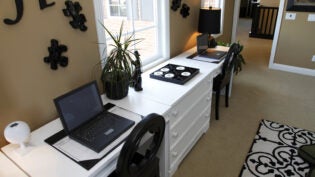
One of the first indications a startup is growing is when the business moves from the basement into an office. What we call startups today were some of the earliest businesses to explore “shared office space” because often they could not stay in the home but also couldn’t afford traditional office space, so often they partnered with 1 or more other fledgling companies to rent a space.
Today not just startups but freelancers, professionals (white and blue) and small businesses seek many forms of flexible workspace. Flexible workspace is all shared office space where the terms are not based on “traditional office space” leases. Payment terms can be a monthly rental fee (usually on month to month terms) or in the case of coworking a membership (usually monthly in term) grants access to a set group of features and services.
For startups or Fortune 500 companies flexible workspaces provide:
- Lower Real Estate costs
- Lower overhead with business machines, reception and IT/internet handled by the provider
- Fantastic networking opportunities
- Many providers can easily handle exponential growth
Yes, Fortune 500 companies are jumping on the coworking/flexible workspace bandwagon for all the reasons listed above and more. Of course, the changes in corporate culture due to a younger work force that doesn’t see the need to report to work between 9-5. So, it’s not just lower costs it’s what workers want and will give up to have a flexible work schedule.
What are a Startups’ Shared Office Space Options?
For many different reasons some startups still go the traditional office space route despite the extra costs. Many startups and other businesses choose one of the following flexible office space solutions:
- Coworking office space (membership)
- Semi-private office space (generally 2/office)
In my post Moving Your Startup from the Garage to an Office Space I discussed how having a virtual address or better still a virtual office enables a business to easily go from the garage to an office space often without a change of address or phone number (less of a hassle these days). For businesses with the foresight to go the virtual route for their contact points while in the basement the move to an office is as easy as going to the coworking or business center with your computer! Everything else you need is already in place!
The Pros and Cons Of Coworking Office Space
Coworking office space provides most or all of the benefits listed for the benefits of flexible workspace. Yes, coworking workspace is the low cost alternative with the best terms, but, with that comes some negative characteristics. These include but not limited to:
- Less privacy around the workspace (the degree to which it is a negative depends on members)
- Generally coworking access is limited to the centers’ hours
- Mail, reception and meeting rooms are often not included
The big intangible with coworking office space is the providers’ ability to provide networking and learning/mentoring opportunities. Some are good at it, however, others are not so be careful basing your decisions solely on price.
Pros and Cons of Shared Office Space (semi-private)
Many shared office space providers are primarily business centers with some mixed providers who provide both coworking workspace in addition to the more traditional “hot desk”, private and team space products business centers are known for. Obviously these office solutions provide far more privacy often with not a large increase in costs.
In my experience as both a user and industry insider it is somewhat misleading for coworking spaces to claim they are the only flexible workspace option that provides mentoring, advice and networking opportunities. Many Business Centers’ understand that fostering their community leads to growth in the companies and consequently more business for them.
The negatives to shared office space are not many or very large barriers:
- Higher cost than coworking (with more privacy and services)
- Sometimes there are no storage facilities so paperwork etc. is not secure and consequently must be transported to the office upon each visit
Conclusions
Flexible workspace is not just about design and functionality it’s also about the flexible work hours and flex time employees want and will take less pay to get! Coworking is enticing based on price and networking environment, however, don’t discount some business centers’ bring the same qualities as coworking with value add services coworking doesn’t provide.
 Author: Terry Van Horne has been developing and marketing websites since the early 90’s. In 2007 Terry developed a YouTube Marketing Strategy for WorldMusicSupply and to date those 300+ videos have received over 30,000,000+ downloads.
Author: Terry Van Horne has been developing and marketing websites since the early 90’s. In 2007 Terry developed a YouTube Marketing Strategy for WorldMusicSupply and to date those 300+ videos have received over 30,000,000+ downloads.
In 2010 Terry and David Harry founded the award winning SEO Training Dojo, voted by TopRank users as the Top Private SEO Community. Terry is currently the Community and Online Marketing Manager for Telsec Business Centres. He is enjoying sharing small home based business information in the community and elsewhere.
2869 Views












